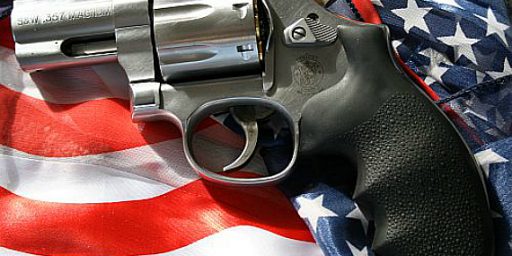Understanding Iraq’s Checkpoints
What Iraq’s checkpoints are like (Annia Ciezadlo, CSM) [also at CST]
Editor’s note: On Friday, an Italian intelligence officer was killed and Italian journalist Giuliana Sgrena was wounded as their car approached a US military checkpoint in Baghdad. The US says the car was speeding, despite hand signals, flashing white lights, and warning shots from US forces. Ms. Sgrena says her car was not speeding and they did see any signals. This personal account, filed prior to the shooting, explains how confusing and risky checkpoints can be – from both sides.
It’s a common occurrence in Iraq: A car speeds toward an American checkpoint or foot patrol. They fire warning shots; the car keeps coming. Soldiers then shoot at the car. Sometimes the on-comer is a foiled suicide attacker (see story), but other times, it’s an unarmed family.
As an American journalist here, I have been through many checkpoints and have come close to being shot at several times myself. I look vaguely Middle Eastern, which perhaps makes my checkpoint experience a little closer to that of the typical Iraqi. Here’s what it’s like.
You’re driving along and you see a couple of soldiers standing by the side of the road – but that’s a pretty ubiquitous sight in Baghdad, so you don’t think anything of it. Next thing you know, soldiers are screaming at you, pointing their rifles and swiveling tank guns in your direction, and you didn’t even know it was a checkpoint.
If it’s confusing for me – and I’m an American – what is it like for Iraqis who don’t speak English?
In situations like this, I’ve often had Iraqi drivers who step on the gas. It’s a natural reaction: Angry soldiers are screaming at you in a language you don’t understand, and you think they’re saying “get out of here,” and you’re terrified to boot, so you try to drive your way out.
This certainly explains a lot about the Sgrena situation.
Update (0854): Andrew Olmsted adds a firsthand account:
I’ve been Iraq-bound training units on how to run traffic control points (TCPs) just like the one that fired on Ms. Sgrena’s vehicle for most of the past year. The biggest threat such units face is a vehicle borne improvised explosive device (i.e. a car bomb) detonating in their midst, so the TCPs are designed to stop vehicles well away from their center, allowing the minimum number of soldiers to risk contact with an approaching vehicle. Vehicles which approach a TCP and fail to stop are dealt with very simply: they are engaged with rifle and machine gun fire because they may be VBIEDs which could destroy the entire TCP. Because this threatens to lead to accidental killings like that involving Ms. Sgrena, we warn units to place signs well forward of the TCP telling drivers they are approaching a TCP and need to slow down and stop or they will be fired upon. The TCP is a delicate balance between protection of the soldiers manning the TCP and protecting the innocent people who come through the TCP.
Cori Dauber observes,
Here’s the bottom line: there are calls for making checkpoints safer on the margins (larger signs, bigger, brighter lights) and those all sound like good ideas. But the real heart of the matter is that the troops have clearly been told to act as if any vehicle that fails to slow down after a certain number of warnings is hostile. That’s where they place presumption: the risk of letting through a suicide bomber is greater than the risk of fatally shooting civilians.
And that’s what’s really upsetting the critics. They want presumption placed the other way. They want the troops to act as if the risk of shooting civilians, fatally or not, is a greater risk than letting through a suicide bomber or a drive-by shooter.
Jim Henley continues to wonder, though, whether our soldiers are acting according to their training. As he argues in a previous post,
It’s an article of faith among hawks that the Pentagon’s assertions that the US goes out of its way to minimize civilian casualties are true. I think they’re true to an extent – when planning an offensive operation at leisure, I believe the US generally targets its precision-guided munitions carefully. But I don’t think casualty minimization survives as a priority in the heat of ground operations or the stresses of “peacekeeping.†Force protection, the overriding principle of contemporary American military doctrine, trumps casualty minimization.
A quarter century ago, I learned in my military ethics class that soldiers have a duty to minimize civilian casualties even at the risk of their own lives. We can’t, for example, simply burn down a village with dozens of civilians in it to avoid the risk of getting soldiers killed taking out a sniper. In conventional combat, though, we at least have a situation where identifying the enemy is relatively easy: they wear a different uniform. In counter-insurgency/counter-terrorism, that’s seldom the case. One rather has to presume that a car coming to a checkpoint that isn’t stopping is hostile.
The presumption of which Dauber writes shifts depending on the circumstances. At, for example, a police roadblock in the United States, we would expect the rules of engagement to require the officers’ shooting at the last moment, after having taken heroic measures to get the car to stop otherwise. In a pure war zone, we would expect the soldiers to shoot at the slightest hint of danger. In post-election Iraq, our forces are in a gray zone between war and peace.
Certainly, I support reasonable measures to make the roadblocks more obvious, especially at night. That should include, immediately, a serious media campaign within Iraq to make sure people know what the procedures are. Beyond that, though, I expect the ROE to be set to maximize the safety of our soldiers. If you’re in Iraq and come to a checkpoint manned by uniformed soldiers, you stop. That much should be obvious in any language.
Update (1102): A commenter points me to John Burns’ piece in today’s NYT, “U.S. Checkpoints Raise Ire in Iraq [rss].” It adds strength to my argument above that we need to do a better job of communicating the ROE to ordinary Iraqis.
Next to the scandal of prisoner abuse at Abu Ghraib, no other aspect of the American military presence in Iraq has caused such widespread dismay and anger among Iraqis, judging by their frequent outbursts on the subject. Daily reports compiled by Western security companies chronicle many incidents in which Iraqis with no apparent connection to the insurgency are killed or wounded by American troops who have opened fire on suspicion that the Iraqis were engaged in a terrorist attack.
[…]
The confusion arises, in most cases, from a clash of perspectives. The American soldiers know that circumstances erupt in which a second’s hesitation can mean death, and say civilian deaths are a regrettable but inevitable consequence of a war in which suicide bombers have been the insurgents’ most deadly weapon. But Iraqis say they have no clear idea of American engagement rules, and accuse the American command of failing to disseminate the rules to the public, in newspapers or on radio and television stations.The military says it takes many precautions to ensure the safety of civilians. But a military spokesman in Baghdad declined in a telephone interview on Sunday to describe the engagement rules in detail, saying the military needed to maintain secrecy over how it responds to the threat of car bombs. The spokesman, as well as a senior Pentagon official who discussed the issue in Washington on Sunday, said official statements issued after the Friday shooting offered a broad outline of the rules. In those statements, the military said it tried to slow Ms. Sgrena’s vehicle with hand signals, flashing lights and warning shots before firing into the car’s engine block. But many Iraqis tell of being fired on with little or no warning.
WaPo (“Shootings by U.S. at Iraq Checkpoints Questioned“) has more such incidents.
There is little doubt that young soldiers can get trigger happy. Indeed, during the Gulf War, the decision was made not to allow troops to lock and load their weapons* unless they were expected to be in a firefight because there were incidents of soldiers on guard duty, especially at night, getting a little jumpy and shooting at friendlies.
Still, our troops have been manning checkpoints in Iraq long enough to have smoothed out most of the wrinkles. I’d bet than many of the “no warning” stories are false. Some, undoubtedly, are true.
Don Murphy’s story, “Speeding car can bring life-or-death moment (Seattle Times via CSM),” puts it in a nutshell:
Marine Sgt. Jim Beere knows something about protecting people. Back home he’s an undercover cop in Oakland, Calif., where he works on a special-victims unit tracking rapists and child molesters. He’s usually responsible just for himself and, at most, the safety of a partner. But early on Feb. 22, he saved his own life and quite possibly the lives of a dozen other Marines who were taking a well-deserved catnap after an all-night operation in the city of Hit, 90 miles north of Baghdad. During the same operation, his platoon had killed two unarmed Iraqis who had failed to obey orders to stop. The incidents reveal just how much pressure and how little time troops have to determine whether approaching cars mean them harm.
An undercover cop from Oakland who’s also a Marine sergeant is hardly a kid unaccustomed to high pressure situations. Further, many of the incidents described in all the stories are of innocents who were in fact running checkpoints out of coercion, confusion, fear, or whatever. It’s hard to fault our troops in those cases.
*Instead, we carried live ammunition, loaded in magazines, in the ammunition pouches on our Load Bearing Equipment belts. This meant having 30 rounds fewer on the ready per soldier. It was likely worth that trade-off.





Insightful post, James. John Burns, in today’s NYTimes, has an interesting article on the same issue.
One thing that strikes me is the rather liberal notion of what constitutes a “checkpoint.” According to Burns and other accounts, soldiers walking down the street and gesturing to a vehicle to stop seems to be a “checkpoint.” When you recognize this, it becomes quite understandable to see how a driver might not even see soldiers asking a vehicle to stop. Given the high levels of banditry in Iraq, when “warning shots” are fired, it is easy to see how a driver could mistake them for a carjacking and speed off–which, in turn, can turn fatal.
Link to Burns article: http://www.nytimes.com/2005/03/07/international/middleeast/07patrols.html
So the commie reporter’s scheme has worked and generated the desired response in American media, how precious.
Lets crank out an NSN for a new checkpoint sign, in arabic, that reads
” Hey dumbass, we’re signaling for you to stop, if you don’t, you will be kiled”.